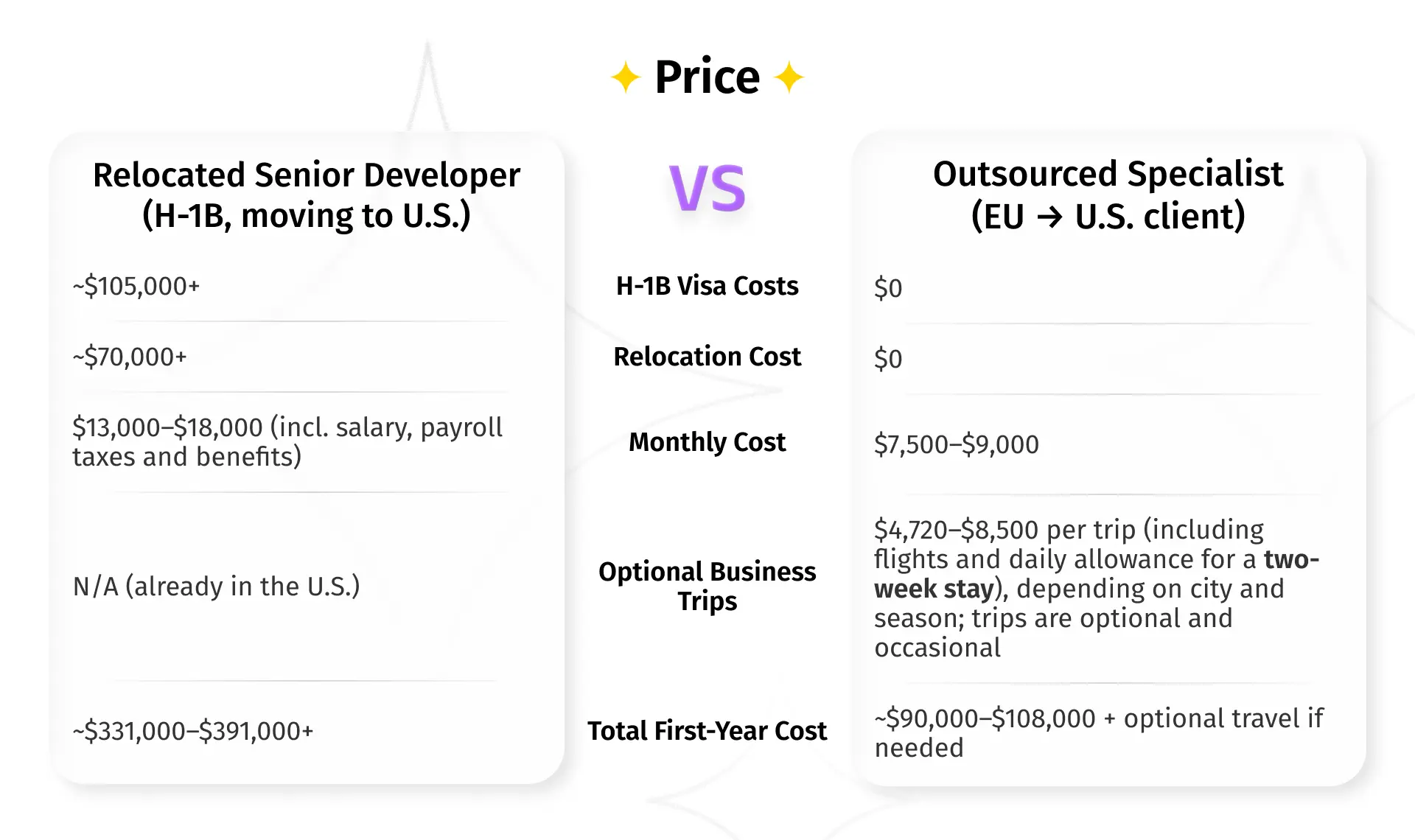US Visa Friction Makes Software Development Outsourcing the Go-To Strategy for 2026

Julia Teryokhina, Senior Presales Engineering Manager
Published: November 27, 2025
In 2024–2025, moving engineers to the US became a high-stakes headache: USCIS filing fees, including the H-1B premium processing fee, spiked, and stricter consular rules forced many to do in-person interviews back home. Then, on September 21, 2025, a massive $100,000 surcharge was imposed on new H-1B petitions — making even top-tier talent painfully expensive. Add a $70K-plus family relocation package, and a single hire can spiral in cost and drag on for months before the first line of code goes live.
Meanwhile, the tech talent crunch is real. Hot fields like AI, cloud, and cybersecurity are outpacing the old visa system’s speed and predictability. That’s why more CIOs are leaning on IT outsourcing services, building dedicated remote teams where the talent already lives, rather than trying to move the world to their company headquarters.
Even with giants like Amazon, Microsoft, Meta, Apple, and Google securing tens of thousands of H-1B approvals in 2025 [2], the outlook for 2026 is clear — the fastest way to scale innovation is to outsource software development to top global talent.
Tech Hiring Shockwaves: What Changed in 2024–2025
For the past couple of years, hiring tech talent by relocating them to the U.S. has become a lot more painful. Whether you’re applying for an H-1B visa to hire new specialists or an L-1 visa to transfer employees from an overseas office, the process can be a headache. To understand why, let’s take a step-by-step look:
1. H-1B Registration – If it’s an H-1B, the employer must first register the candidate in the lottery. That fee jumped from $10 to $215, effective FY 2026.
2. Petition Filing (I-129) – Once selected in the lottery (H-1B) or directly for L-1, the employer files the I-129 petition, which is the official request to bring a foreign worker to the U.S. USCIS increased the fee in 2024 [3]: H-1B filing fee $780 (which is 70% higher than the previous fee) and L-1 filing fee $1,385 (+201%).
On top of that, each petition pays a $600 Asylum Program Fee, which funds USCIS programs like fraud prevention and public services.
Additionally, effective September 21, 2025, a sweeping $100,000 surcharge applies to new H-1B petitions filed after that date. This fee does not apply to renewals, extensions, or petitions filed before September 21, 2025.
3. Premium Processing – If you want faster approval, the H-1B premium processing fee is now $2,805, effective 2025, and guarantees a 15-business-day review.
4. Consular Processing – Once the petition is approved, the employee applies for a visa at a U.S. consulate. Since September 2025, most non-immigrant visa applicants, including H-1B and L-1 holders, have been required to attend an in-person interview. Using a consulate outside the applicant’s home country is basically off the table. That means more travel, longer lead times, and added uncertainty.
So, in total, if you plan to relocate a foreign high-tech specialist to the U.S. in 2026 on an H-1B visa, be prepared to spend roughly $105K. Keep in mind — this estimate does not include travel costs and does not guarantee that the candidate will actually receive the visa. All these changes make hiring U.S.-based tech talent slower, more expensive, and far less predictable than ever.
Extra Expenses of Moving Senior Tech Talent
Now let’s review the hidden price of relocating a senior engineer to the U.S. It’s a major investment with significant costs, risks, and potential delays. Baseline mobility spend usually comprises:
-
- Home-finding and orientation trip: ~$7,500
- Temporary housing (around 60 days in furnished accommodations): ~$15,000
- Household goods move (large shipment): ~$25,000
- Employee travel to the new location (flights, lodging, meals): ~$7,500
- Immigration and legal fees: ~$5,000
- Tax and mobility-assignment services: ~$5,000 for tax services + $5,000 for global mobility management
- Settling-in support, including school enrollment and local orientation
Combined, these relocation basics often start at $70,000+ — and that’s before adding U.S. salary, payroll taxes, and the ramp-up period until the engineer reaches full productivity.
Additionally, there are risk and time factors that add cost, and these extra expenses are hard to calculate because they depend on the specifics of the software project. They include:
-
- Visa appointment delays — consular interviews can push start dates back weeks or months;
- Start-date slippage — even after visa approval, family logistics or moving complications can delay the first day of work;
- Family logistics — schooling, spouse employment, and settling-in support add both time and cost.
All these considerations are driving a shift toward offshore software development.
Global Talent, Zero Borders: Modern Ways to Scale Engineering
When the cost and complexity of relocating engineers keep rising, more companies are shifting to a borderless way of scaling their tech capacity. Instead of spending months navigating visas, temporary housing, and onboarding delays, teams are choosing faster and more predictable ways to grow.
One option is IT staff augmentation, which allows you to bring in vetted specialists on demand without long hiring cycles or relocation risks. It’s a quick, flexible way to boost delivery speed when timelines are tight.
Another strong approach is working with a dedicated development team. These long-term, fully integrated squads function like an extension of your in-house engineering, offering stable velocity and access to niche skill sets that may be hard to find locally. In some cases, it makes sense to spin up Core Teams — compact expert units built for complex engineering challenges.
And for organizations that need broader, end-to-end support, many now outsource software development to partners who can take full ownership of delivery with outcome-based project models and provide the right experts at every stage of the product lifecycle.
Why this model works:
-
- Faster time-to-team — ramp talent in weeks, not quarters;
- Predictable monthly burn instead of relocation guesswork;
- Access to rare or senior-level expertise;
- Time-zone aligned squads for real-time collaboration;
- No immigration, compliance, or relocation overhead;
- Easy rotation as priorities or technologies evolve.
For many organizations heading into 2026, the most efficient way to scale isn’t moving people around the globe — it’s building high-performing teams where the best talent already works. After all, why spend months moving people when you can move tasks instead?
Governance Checklist for Outsourced and Remote Teams
Working with distributed teams or outsourcing development can bring huge benefits, but only if you manage it well. Following a solid governance framework keeps projects on track, protects your IP, and ensures predictable delivery. Here’s a checklist to get it right:
-
- Security & Compliance — Implement DevSecOps practices, maintain SOC2/ISO certifications, ensure proper data residency, and schedule regular audits. This is especially critical when using cloud application development services.
- Delivery Governance — Set clear SLAs, maintain a consistent sprint cadence, track measurable KPIs, and appoint an on-shore product owner to keep priorities aligned with your business goals.
- Legal & IP — Have solid MSAs, enforce invention assignment agreements, and make code ownership crystal clear.
- Change Management — Maintain a shared knowledge base, enable shadowing, and plan overlap hours to smooth transitions and minimize disruption.
- Communication Protocols — Define meeting rhythms, reporting structures, and escalation paths to ensure remote teams stay aligned.
- Quality & Testing — Use automated testing, code reviews, robust QA pipelines, and clear bug-tracking procedures to maintain high standards.
- Team Culture & Engagement — Regular check-ins, feedback loops, and virtual team-building activities help keep remote engineers connected and motivated.
- Onboarding & Ramp-Up — Structured onboarding, comprehensive documentation, and mentorship programs accelerate productivity.
Whether you’re leveraging staff augmentation services or partnering with a nearshore software development company, following this governance checklist ensures that distributed teams operate efficiently, deliver high-quality results, and scale seamlessly as your business grows.
7 Top Questions on Software Development Outsourcing
When you decide to hire remote developers, questions and objections often come up. Here’s how we at Timspark address the most common ones:
"How do we protect our intellectual property?"
Timspark operates as a trusted partner with strong contractual protection, including clear IP ownership and invention-assignment clauses.
"How can we be sure our code and data are secure?"
Timspark provides experienced security specialists and implements robust DevSecOps practices. We also support regular audits, role-based access controls, and secure delivery workflows to keep your code and data safe.
"How will we handle time-zone differences and keep communication smooth?"
We establish overlap windows, clear communication rhythms, on-call rotations, and a predictable demo cadence. And for customers living on the other side of the world, there’s a hidden advantage: when your team works a half-day ahead or behind, you can hand off tasks before they log off — and wake up to completed features ready for testing. It’s essentially two shifts in a single day.
"What if we need to scale the team up or down quickly?
With our elastic engagement model, you can scale your engineering capacity up or down without lengthy hiring cycles or relocation delays. Just share your requirements, and the dedicated developers you need can join your team in a few weeks — or even a few days.
"How do we ensure code quality and engineering standards?"
Timspark follows mature development and QA processes aligned with ISO 9001 and ISTQB guidelines. We implement clear KPIs, automated testing, code reviews, and CI/CD pipelines to ensure remote teams deliver the same high-quality work as in-house engineers.
"Who is accountable for delivery?"
For every project, Timspark assigns a Delivery Manager with a strong technical background who is fully accountable for timelines, quality, and stakeholder alignment.
"How do we keep a remote team engaged and aligned with our culture?"
We speak your language — literally and culturally. Every engineer we select for your team is screened not only for technical expertise but also for cultural fit and communication style.
With the right governance and engagement model — whether through a full offshore development center, a dedicated software team, or flexible augmentation — outsourcing becomes a powerful way to access niche talent, scale fast, and deliver consistently while keeping risk under control.
The Bottom Line: Scale Smart, Not Hard
Looking to scale fast without the relocation headaches? Timspark has you covered. We offer flexible engagement models — team augmentation, dedicated developers, and even end-to-end project development — backed by 1,000+ vetted engineers across cloud, AI/ML, mobile, data, and DevOps. Rates range from $20–$60/hr, depending on skills and scope, so you get the right mix without overpaying.
With 200+ global clients under our belt, we know our way around AWS, Azure, and Google Cloud, and we bring deep expertise in Java, .NET, Node, Python, and other tech stacks. Think of us as your engineering Swiss Army knife — ready for whatever project you throw at us.
Curious? Schedule a 30-minute discovery call, and we’ll map roles, plan your ramp-up, and even propose a pilot squad. No travel required — your coffee break counts as a kickoff meeting.
Ready to scale your team
References
- Restriction on Entry of Certain Nonimmigrant Workers. The White House, 2025.
- Top H-1B sponsoring companies in 2025: Amazon, Microsoft, Google, Apple, and Meta leading US career opportunities. The Times of India, 2025.
- USCIS Announces Significant Fee Increases Effective on April 1, 2024. JD Supra, LLC, 2024.
- Average Employee International Relocation Costs (2025). NRI Relocation, 2025.



